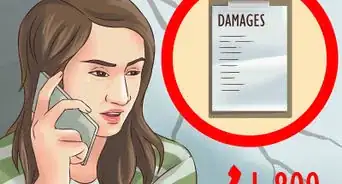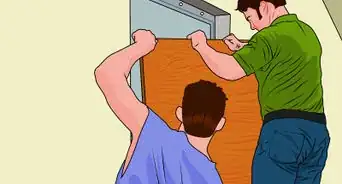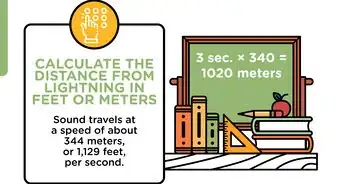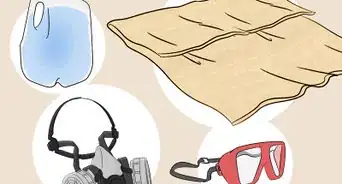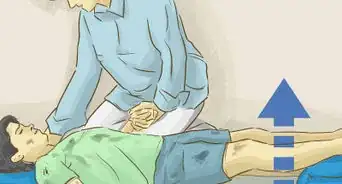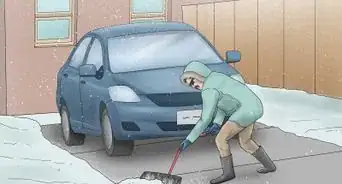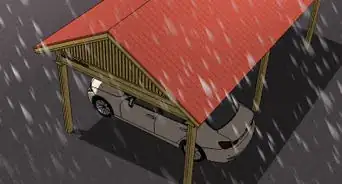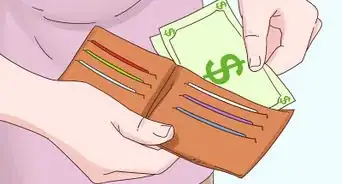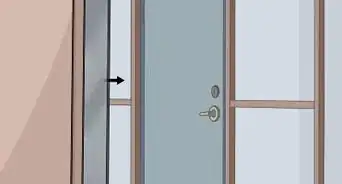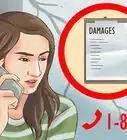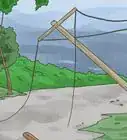X
wikiHow is a “wiki,” similar to Wikipedia, which means that many of our articles are co-written by multiple authors. To create this article, 27 people, some anonymous, worked to edit and improve it over time.
This article has been viewed 44,429 times.
Learn more...
Tornadoes are violent wind storms that can produce winds up to 300 mph (480 km/h) and destroy anything and everything in its path. Scared? Don't be. This article will teach you how to plan for a tornado and protect yourself if one ever comes.
Steps
Part 1
Part 1 of 3:
Preparing for the Storm
-
1Learn more about tornadoes. You will probably be more scared of tornadoes if you don't know anything about them; a good way to mentally prepare for a tornado is to learn about them. Ask a parent or trusted adult to take you to a library or let you read kid-friendly online articles about tornadoes to get a better picture of what they are and how severe they can be. That way if one comes, you may not be as frightened.
-
2Put together a survival kit. Ask your parents to help you gather the following things to put in the kit. It may be a good idea to make a second survival kit for your car.
- A first aid kit
- A battery-operated radio
- Enough flashlights for everyone in your family
- Extra batteries
- Enough non-perishable (canned) food items to feed your family for at least 3 days
- A can opener
- Enough bottled water for 3 days
- Protective clothing for everyone
- Written instructions on how to turn off the gas, water, and electricity
Advertisement -
3Put together a disaster plan and make sure everyone knows it. Ask your whole family to sit down together and talk about what you should do and where you should go in case of a tornado. Make sure to cover everything you can think of, including what you should do if you're outside in the yard or even in the car.
Advertisement
-
1
- Remember to include your pets! You should choose a sturdy, interior room on the lowest floor of your home (preferably the basement if you have one), away from windows (such as a bathroom or closet) to gather in during a tornado. Your shelter room should have your survival kit stored in it for easy access.
-
2Make sure you know other important information. This could include:
- What it means when the siren sounds (some areas sound it for severe thunderstorms too)
- What county or parish you live in
- Your home address
- Other tornado safe homes or businesses in the area
- Your parent's contact information
Advertisement
Part 2
Part 2 of 3:
Staying Safe During the Tornado
-
1Prepare for a tornado if a watch is issued. The sirens will not sound for a tornado watch in most areas, but you still need to keep an eye on the weather in case you are put into a tornado warning. Turn on the local news or listen to a radio so that you stay up-to-date on the storm. It is not recommended to go to sleep or leave your home just in case a tornado does hit.
-
2Head to your safe room or shelter area as soon as a tornado warning is issued. If you hear the sirens, immediately awaken your family if they are asleep and head to your safe room or shelter. Warnings are issued when a tornado is in your area and is almost guaranteed to hit. Especially if the storm is already upon you, get yourself and your family to the basement quickly and safely. Don't forget your pets!
- If you have a few extra minutes, consider grabbing bike helmets. It may sound silly, but wearing a helmet during the tornado will protect your head from flying debris and broken glass, and possibly even save your life. For toddlers and babies, strapping them into a car seat will protect and stabilize them during a tornado just like it would in a car accident.
- For even more protection from the tornado, sit underneath a heavy piece of furniture such as a table, or lay in the bathtub with blankets over the top of you. Pretty much anything between you and the tornado will help keep you at least a little bit more protected.
-
3Stay in the safe room or shelter area. Nothing is worth going back for once the tornado hits, unless it is another person (in which case an adult should go back). You shouldn't go back for a stuffed animal, picture album, or even your pets. None of those things are worth risking your life for.
- Unless your pets are caged up they will be smart enough to take shelter during the tornado, so don't be too surprised if they join you in your safe room at some point.
-
4Listen to the battery powered radio to stay informed about the storm. Even after you think the tornado is gone or it has been announced on the radio, remain in your shelter for at least 20 minutes or until any remaining lightning or thunder has passed. It can be just as dangerous as the tornado itself, and could be a sign that more bad weather is on the way.
Advertisement
Part 3
Part 3 of 3:
Seeking Help After the Tornado
-
1Stay in your shelter or safe room until you are sure the danger has passed. However, if your shelter has been severely damaged or you or someone else is injured, it may be better to get out and seek help. Emergency services will be on the scene of the storm almost immediately after it has passed.
-
2Keep yourself and others calm and safe. This is where your survival kit comes in handy.
- Give everyone a flashlight. This will not only help you to see, but to keep yourself safe from other potential dangers after the storm and signal rescuers and emergency services for help. Make sure to keep the extra batteries nearby in case your flashlight dies.
- Check for anyone who is injured or trapped without putting yourself or others in danger. Use your first aid kit and help as much as you can while you wait for the emergency services to arrive.
- Have an adult inspect your home for hazards if possible. Broken glass, downed power lines or trees, and other debris are things you should watch out for. Reduce the risk of further danger by turning off the electricity, gas, and water if you can do it safely.
-
3Seek help.
- Disaster relief stations will most likely be set up by churches or organizations such as the Red Cross within a few hours after the storm. They will have a place for you and your family to sleep, eat, and get medical treatment or assistance. Try to make your way to one or find somebody such as a rescuer to help you get there. Only wait for someone to rescue you if you are physically unable or are trapped in your shelter; the relief workers will have enough to do already. Mark your home with a flag or note of some sort if you can to alert them you have already gotten out safely.
- If you are trapped or physically unable to get out by yourself, try to signal for help. There will most likely be a lot of talking, shouting, and other noises going on in the aftermath of the tornado, so separate yourself from the rescuers by signalling in groups of three. Three shouts, three whistles, three claps, three flashes of your flashlight, etc. as that is the global distress signal.
-
4Salvage what you can from the wreckage. Once it has been deemed safe for you to go back to your home, try to find anything that survived the tornado. You likely had lots of items that were special to you and your family such as photographs, toys, books, or clothes. Maybe some of these things were left unharmed! Try not to get your hopes up too high, though; you may not find much of anything that is still worth keeping.
-
5Try to move on. Tornadoes can be scary and devastating, but you need to keep your head held high. You can help clean up the debris and repair or rebuild your home or other buildings. Plus, just think of all the new toys and clothes you'll get, or how much closer your neighborhood will become in overcoming the disaster. Not everything is a total bust.
Advertisement
Community Q&A
-
QuestionHow can I sleep and survive if I have no home?
 Community AnswerThere is usually a safe shelter for sheltering away from tornadoes, stocked with food, first aid items and sleeping bags. These are usually located in the town hall. Ask your parents to take you on a tour of one well before a tornado is ever in your area, so that the whole family knows where to go and how to keep safe during and after the tornado. If you do lose your house, people will help you and family out.
Community AnswerThere is usually a safe shelter for sheltering away from tornadoes, stocked with food, first aid items and sleeping bags. These are usually located in the town hall. Ask your parents to take you on a tour of one well before a tornado is ever in your area, so that the whole family knows where to go and how to keep safe during and after the tornado. If you do lose your house, people will help you and family out. -
QuestionWhat will I do if my house gets destroyed and I have nowhere to go or to live?
 Community AnswerYou can stay with friends or family. If this is not an option, you can stay in a hotel or at a shelter.
Community AnswerYou can stay with friends or family. If this is not an option, you can stay in a hotel or at a shelter. -
QuestionWhat if you aren't in a safe place and cannot get to one?
 Community AnswerIf your home is made out of bricks or concrete, find the most stable wall and lie/sit at the bottom of it. You can hide in a bathtub with blankets on top of you. If these are impossible, find the deepest ditch/hole to lie flat in. If you have any kind of helmet, put that on.
Community AnswerIf your home is made out of bricks or concrete, find the most stable wall and lie/sit at the bottom of it. You can hide in a bathtub with blankets on top of you. If these are impossible, find the deepest ditch/hole to lie flat in. If you have any kind of helmet, put that on.
Advertisement
Warnings
- If you see a tornado getting bigger, and not going to either side of you, it is coming towards you. Seek shelter immediately.⧼thumbs_response⧽
- When a tornado passes, look around for any downed wires or trees, broken glass, or other unsafe debris so you don't get a serious injury or possibly die. Always wear closed-toed shoes and protective clothing to minimize danger.⧼thumbs_response⧽
- Whatever you do, don't try to look outside a window or go outside to check if the tornado is gone. Listen to the radio and use your common sense.⧼thumbs_response⧽
- Don't try to outrun a tornado! Simply find a shelter or crouch down in a ditch.⧼thumbs_response⧽
- Cars and mobile homes are not safe shelters from a tornado. It is much safer to crouch down outside in a ditch than be inside one of them.⧼thumbs_response⧽
- Never go outside during a tornado, as this can cause serious injury and/or death.⧼thumbs_response⧽
Advertisement
Things You'll Need
- Shelter
- A disaster plan
- Survival kit(s)
References
About This Article
Advertisement
-Step-1-Version-2.webp)
-Step-2-Version-2.webp)
-Step-3-Version-2.webp)
-Step-4-Version-2.webp)
-Step-5.webp)
-Step-6.webp)
-Step-7.webp)
-Step-8.webp)
-Step-9.webp)
-Step-10.webp)
-Step-11.webp)
-Step-12.webp)
-Step-13.webp)


